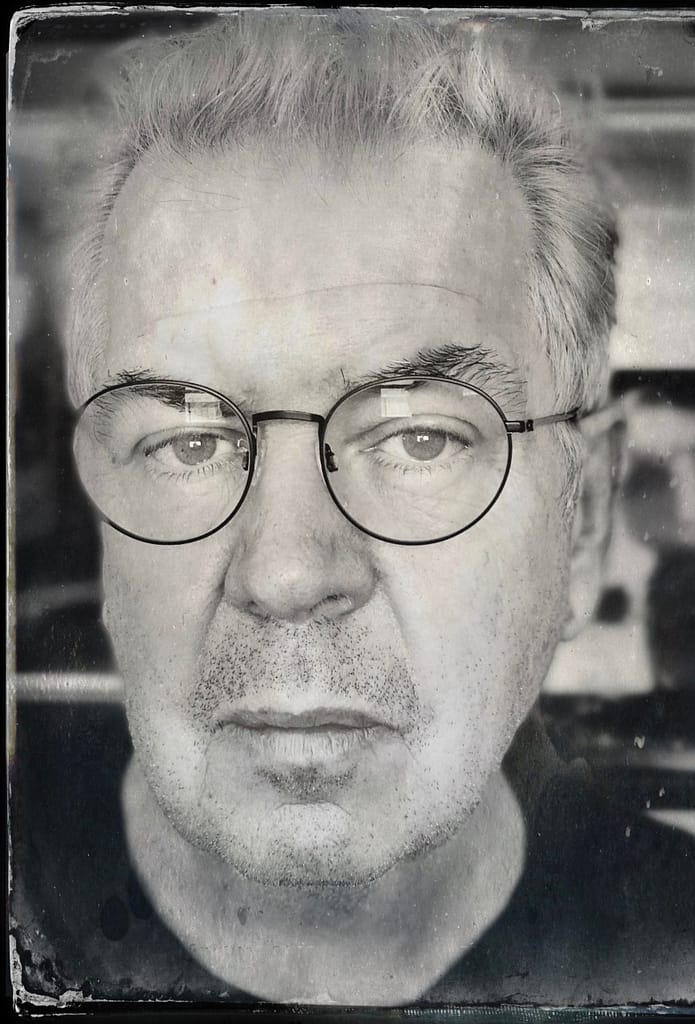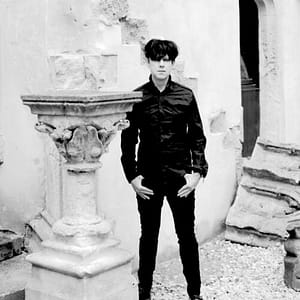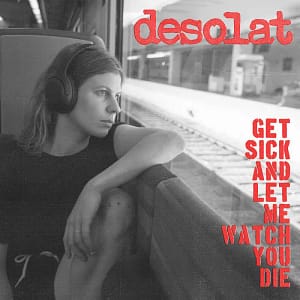Being the co-founder of an iconic rock band that defined an era and influenced, in many ways, at least two future generations of fans and musicians. This inevitably gives you a legendary halo, how could it not?
And yet Lawrence “Lol” Tolhurst (class of ’59) who co-founded The Cure in 1976 – together with his friend Robert Smith – is a kind and peaceful man who has never abandoned his practical vision of his job. Even though he’s aware of the great relevance that creature represents to this day.
After the flaming “divorce” from the band in 1989, Tolhurst took stock, got sober, and began to build a new career without ever living off the fat of the land. Indeed, getting involved in new projects with the same enthusiastic passion that saw him creating The Cure; continuing to grow the art of music with curiosity and intelligence.
After the beginning of the new millennium, he formed the duo Levinhurst with his wife Cindy Levinson (met in Hollywood and married in 2002), living a different dimension of fame and returning to playing – especially on the stage – the drums, as in The Cure’s first albums.
Recently he’s been promoting a new podcast co-hosted with Budgie – legendary drummer of Siouxsie and the Banshees/The Creatures – entitled Curious Creatures. The project explores “the enduring legacy of post-punk and its contemporary relevance”. The podcast launched in October and is available on all the streaming platforms, including Apple, Spotify, and Google, or on the official website which is full of interesting exclusive content. Tolhurst and Budgie answer questions sent in by the audience in the second half of each episode and most episodes have a special guest.
Even if divided by an infinite amount of miles, thanks to the precious intermediation of his press agent, we got around the time-zone having a wide-range conversation about the past history of the Cure and his current vision of things
Deca – Good evening Lol. Let’s start from the present. Just yesterday morning I was listening to some track by Levinhurst and my perception has been this: a relevant and stratified baggage of artistic experience. I feel an elegant evolution of what you learned playing in The Cure. We can appreciate this – for example – listening to your new version of “All cats are grey.” Then I think, “Lol Tolhurst spent almost twelve years of his life playing with The Cure, but from 1989 to the present day, he spent other thirty years making music!” What are the most relevant elements in this evolution after The Cure? What kind of influences have you gathered to reach your current personal style?
Lol – I feel that the years after The Cure have been most important because they represent a growing up into real life. It’s pretty magical still, but it’s vastly different from the life I had in The Cure. I am still immensely proud of what we did with The Cure, but I feel this part of my life will be more helpful to people and is a more accurate distillation of my creative journey…Influences? My life is the influence of everything. I don’t mean that in a flippant way, I mean sincerely that creation and my everyday existence are completely entwined.
Deca – You began as a drummer, in The Cure line-up. You were not a virtuoso like the drummers of prog-rock scene usually were; but… your drumming style was so distinctive and I think that in the first albums of your discography your rhythm style was as fundamental as Robert’s voice and guitar were. I’m talkin’ about how you used the splash cymbal, for example. Minimal precise sounds: perfect for those songs, for those atmospheres. A song like “A forest” wouldn’t be the same without that rhythm structure.
Lol – Unlike many of our contemporaries, we did not seek to emulate our heroes. We strove to find our own style. We rejected a lot of the overblown histrionics of prog-rock but wanted to maintain (at its better points) the intensity and emotional content. A friend noted it’s the mistakes you make that become your sound. With us it was our limitations that became us.
Deca – “Pornography” has been a true turning point. Today this album is considered a milestone in the post-punk scene and in whole rock culture, after all. Its popularity has increased a lot, over these 40 years. Keep talking about drums… in “Pornography” your drumming is heavier and more “dirty”. You used deep and low toms; resonant snare; and cymbals were so crashing. I adore your work in “The Figurehead” and “Cold”. There’s a sounds mixture quite different from “Seventeen Seconds” and “Faith.” How was that sound born? Was it a spontaneous need inside a creative process? Or did you rationally decide?
Lol – We had thought to use a different collaborator for this album. Up until then, it had been Mike Hedges. We talked to Conny Plank first, so there was a rational idea that we were going to change. In the end, we chose Phil Thornalley, who was just 21 when we recorded this! I think we gave each other permission to sound the way we did. We were all very young, so nothing was set in stone as regards the sounds we made. It was quite a difficult record to make, and yet at the same time, it was and is still to me our freest, most natural record. Incidentally, we were listening to the final playback of “Disintegration” in RAK Studio years later in the same place where we made “Pornography”, so it has much personal symbolism to me as a place and time! The place where the best and the worst things happened to me! (laughing)
Deca – After “Pornography” the band lived a transitional period, with a more electronic production, more synths, more drum-machines. And a taste of jazz, too! It was 1983, there were “The Walk” and “The Lovecats” in our cassette decks. Then, in 1984, when you became a full-fledged keyboard player, The Cure recorded a new album (The Top) that didn’t sound so electronic. Songs like “Shake Dog Shake” and “Give Me It” are full of distorted guitars. Do you think that your fans – at that point – had different expectations? “The Top” is considered a transitional work too, a bridge from the dark disease of “Pornography” towards the oneiric mood of “The Head On The Door”. For what concerns me, “The Top” is a great work. I see it as an essential step in your discography.
Lol – You are correct! “The Top” was an essential transition for us from the intensity of “Pornography” through the electric and jazz singles. It was a calm and tranquil album to make in many ways—just me and Robert with Andy, who was new to the band. I don’t recall much angst or trouble making it. It was necessary to our soul as a band. It also has some of my favorite lyrics I ever wrote on it for “The Caterpillar” and “Piggy in the Mirror”. I was thinking about this time recently as one of the regular visitors to the studio was a record company guy who just passed away recently. It reminded me that time waits for no man.
Deca – Since I’m a pianist and a synth player, I’m very curious about the instruments you chose. Tell me something about your keyboards for studio recording sessions. And something about the way you organized your keyboards set on the stage.
Lol – I liked all the early EMU keyboards, the Ensoniq Mirage samplers and used the latest version of those plus Oberheim sample players live. In the studio, we would bring all our collection of keys, the Arp Solina chief among them; and use the studio’s piano. In many ways, we were also victims of the times we used the ubiquitous DX7 and the Fairlight! Most of my brief when in the studio at the start of sessions was to find exciting and unique sounds to use. I think I’m better at that than being a virtuoso player! (laughing)
Deca – Life on the stage… The Cure, after the middle of the ’80s, started to play into bigger and bigger locations. I remember your gigs for The Head Tour and Kissing Tour, with a 5000/10000 spectators audience, here in Italy. Today your live performance are placed in a different dimension, more confidential, more intimate and cozy. That’s a very right dimension for a certain kind of music, because you can give something more to your audience; and you can manage audio technical aspects in a perfect way. How do you feel about this? Coming back to the snug stages of your origins after a true feast of huge locations. Coming back to play drums, above all.
Lol – In the end, drums are my true love as they are so visceral, and as you get older, it feels good to be able to play them still! They are very abstract and emotional as an instrument. Smaller places to play certainly allow more control and intimacy, but too small gets scary when people are very close. I feel best in 1000/2000 venues. The places we played for reflections were a little bigger, but that feels the correct size to me.
Deca – Talking about look and trend, The Cure determined a sort of standard, in those years. An iconic reference point for all the dark generations: feathered hair, creeper shoes, black eyeliner, black shirts… The Cure’s Dresscode was one of your trademark. How do you think this look has influenced your artistic appeal? Was it an inevitable cultural element you couldn’t ignore? I got a huge collection of pics: in your early years, your wardrobe was so variegated, a mix of punk, dandy and rock’n’roll rebel.
Lol – Obviously, our look became distilled into its core elements as time wore on. A way to identify who you were. Now it’s almost the uniform of a sub-section of society. I admit it feels good to have a hand in that! At the start, you’re correct it was more varied experimenting with stuff really. To see what would fit (no pun intended).
Deca – In 1983 you were the producer of the debut album of a band I love so much: And Also The Trees. Great lead voice, great guitars sound, great atmospheres. These guys have been the most underrated protagonists of british new wave scene. Tell me something about this experience, please. I know well what to be a producer means. You work on a higher level of artistic sensibility, you are a sort of alchemist.
Lol – I have always been interested in how sound and music affect me emotionally. It’s not just an intellectual process for me. My favorite music and sounds always have those elements. as a producer I try to bring that out in the other artists I work with. And Also The Trees are very good for that their music is very emotional to me.
Deca – You work with your wife Cindy, today. So many years together and an excellent artistic journey. As Levinhurst you have published an interesting series of records. And I see you breathing and playing peaceful, isn’t it? When I listen to song like “Somewhere Sometime” I truly hope this project goes on. Even if I don’t know what you’re scheming now! Disclose me something new, please.
Lol – Well, there many things on the horizon!! Books, albums, films, TV… But you are correct: I have good existence now peaceful with my wife and son in my life; and mostly I get to do what I want to do! Do I have a regret? That I didn’t know some of what I know now as a younger man, but of course that’s impossible, so no regrets. Life is beautiful.
Curious Creatures Podcast
https://curiouscreaturespodcast.com/








